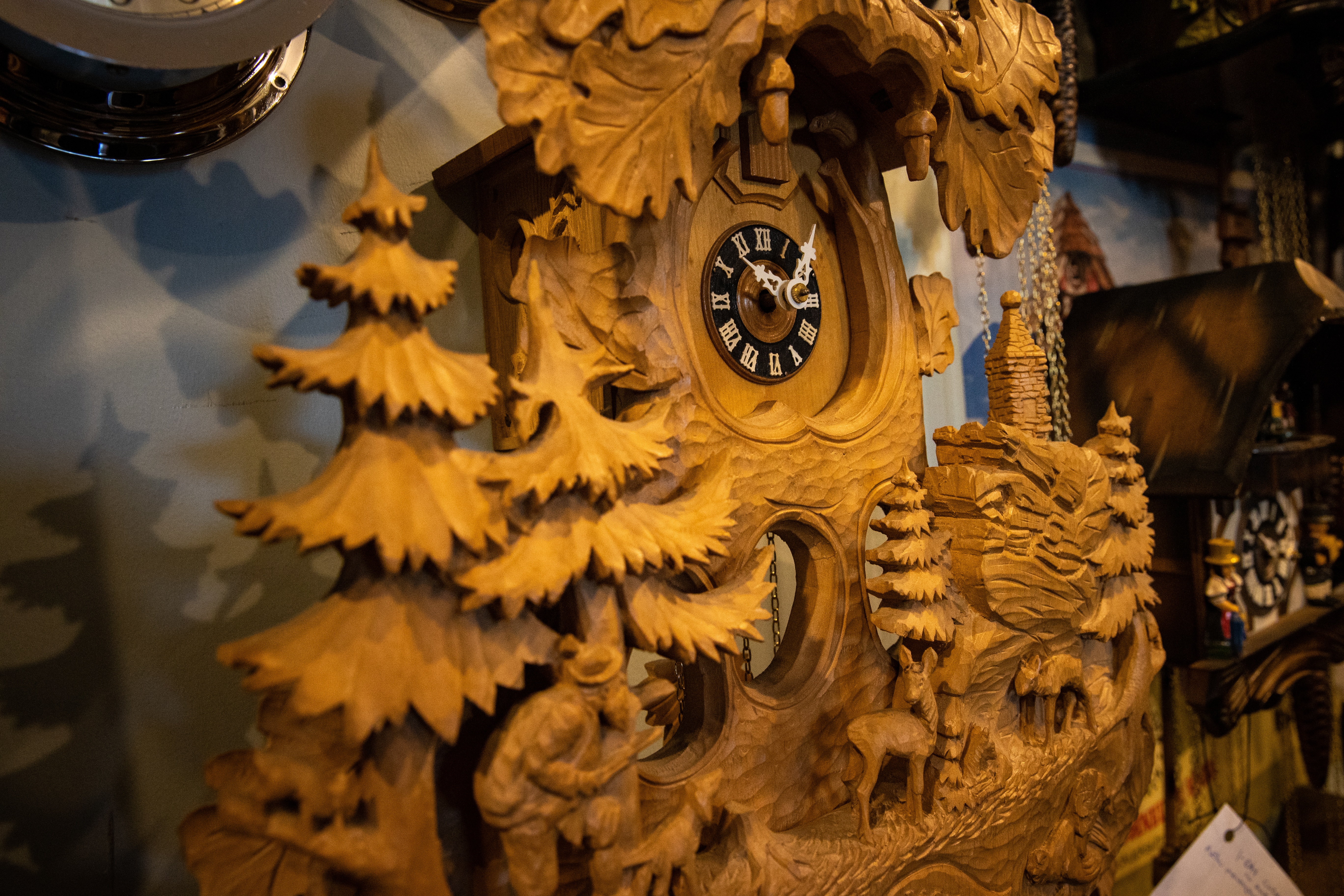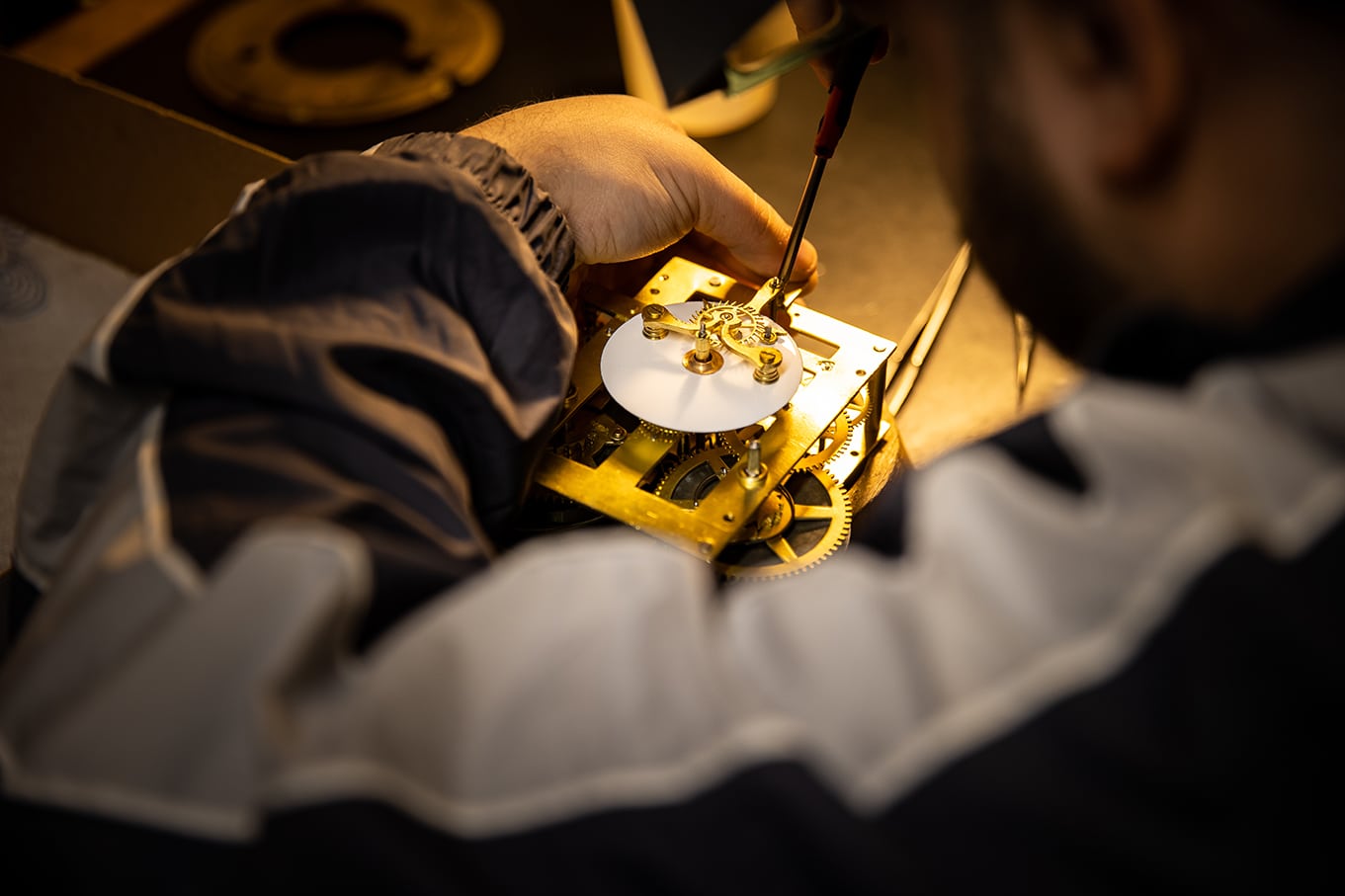Avisit to The Clockery on 14 Van Zant Street in Norwalk is like stepping into another dimension–a place where being present is a way of connecting to the past. Frank Domotor is the owner and head clocksmith, but it wasn’t always that way. Established in 1972, Frank recently took the helm from the previous owner and founder Bucky Taylor who first worked as a draftsman of General Time Corporation in Stamford. 50 years ago, Taylor founded The Clockery as part of an antique shop and built the business from scratch, and the story that led to Frank’s passion for clocks is literally cuckoo.
“Frank was always our cuckoo expert,” Bucky says with a laugh.
“When I was a little boy growing up here in Norwalk, I learned to tell time on a cuckoo clock. I remember my dad telling me to ‘stop pulling on those chains’ and ‘leave that clock alone.’ By the time I was a teenager, my dad couldn’t keep the thing going and put it away. My mom went back to her family home in Austria, and she brought home a new cuckoo clock,” Frank explains. “But I liked that old clock. I missed it.” So, Frank got permission from his parents to try to repair the old clock. “I have always been mechanical. Ever since I was a little kid, I took things apart and put them back together. I eventually got the broken cuckoo going.” From that was born a passion fueled by a young man in love.
“I was in my late teens when I fixed that first clock, and my girlfriend Karen (now my wife) encouraged the whole thing. She found one clock at a tag sale, then another at an estate sale, and I started repairing them,” Frank elucidates.
How it all began

The couple started calling into a radio show on WICC Sunday mornings where people could sell and buy items, and they began buying old cuckoo clocks for $30 or so each. “The light bulb went off when Karen came home with a cuckoo from the 1800’s. It was the coolest thing I had ever seen,” he explains.
Frank soon had amassed many cuckoo clocks that he started running into issues he couldn’t figure out. So, he headed to his local clock shop, The Clockery, and asked Bucky to help him understand how to make the repairs he needed to make. Bucky was so impressed by his skills and thirst for knowledge that he offered him a job.
“We had him doing repairs from home for years,” Bucky says.
“I began by doing very simple things, and after some time, I set up a little shop at my house. They would subcontract the work to me, and I would do the repairs part-time,” Frank explains. Frank also had a full-time job at Trafalgar Leather Factory, first located in Norwalk and later New York City. “I worked my way up from unloading trucks and working in the warehouse to a management position I held for over 30 years,” Frank says.
Frank worked for The Clockery in the evenings and on weekends throughout his career. He was, and is, always learning. Over time he invested thousands of dollars into his own equipment, and the owners of The Clockery trained him to do even more sophisticated work. “I slowly built my way up to more complicated work. Finally, it got to the point where I was doing stuff they wouldn’t touch,” he explains.
Frank walks me through his showroom, showing me each clock as if he is introducing me to some of his closest friends.
The wonderful world of clocks
“This one here is the Elliott of London. It’s very collectible, one of the nicest clocks Elliot probably made,” he says while we gaze at the face of a finely etched brass grandfather clock with a hand-painted dial that tracks the phases of the moon.
There are french porcelain mantel clocks, grandfather clocks made in England, Scotland, and many from the clockmaking capital of the world…Connecticut.
“By the late 1800s, clockmaking was one of the leading industries in Connecticut. Companies such as the New Haven Clock Company, the Waterbury Clock Company, and Thomaston made some of the finest clocks produced in the world at that time,” he explains.
“Check out this clock,” Frank guides me towards the oldest clock in his showroom. “This clock was made in 1690. You’ll notice it only has one hand. The first clocks did not have a minute hand, they only had an hour hand, and you would say ‘well yeah, if it was halfway between it’s 2:30.’ Anything in between was sort of a guess. Then later, we started adding the minute hands.”
He talks about tubes and chimes and strike service in rapid-fire. The gears in his mind whirring with stories like the inner mechanism of an exquisite clock. The clocks are comforting, always ticking in the background as we speak.
Many of the clocks in the showroom have been bought in disrepair. Frank and his staff repair them on demand once they have a buyer or if they have some downtime. “Those clocks go to the front of the list for repairs once we have a buyer.” Frank explains.
When one worker retired in 2005, Frank moved his equipment from his home workshop to The Clockery and started working on site. A few years later, Bucky asked Frank to buy him out, and Frank quit his corporate job and took the leap.
“When I put my notice in at my full-time job, they almost fell out of their chairs. They couldn’t believe it. They thought I would stay there for life. So when I finally cut the cord, it was a little scary. But it’s been the best decision I ever made,” he said. “I wish I’d done it sooner.”
But guess who didn’t retire? Bucky. Even though he sold the place to Frank a few years ago, the 80-year-old still can’t walk away.
“I love it. I planned to retire, and then I missed it. So here I am. Plus, Frank needs the help,” Bucky says.
“I sure do! We are busier than ever,” Frank says warmly.
A successful career
“I’ve restored over 10,000 antique clocks in my lifetime,” Frank says. “There’s nothing I haven’t seen. I’m up in church steeples repairing the tower clocks; I’m doing repairs on $500,000 museum pieces. I have people shipping me pieces from all over the country. I’m here in the shop working over 70 hours a week.”
Frank makes house calls every evening, and there is a six-month waitlist on repairs.
“I service one to two grandfather clocks every night,” Frank explains. “People are always shocked by how many clocks are out there, but we are located right in the heart of the Gold Coast. Many people here have very expensive and beautiful clocks that need regular service every four to five years.”

Frank’s 26-year-old son, Alex also works in the shop full time and will likely take over the business one day.
“I feel so blessed to be working by their side and learning all the tricks of the trade from these two experts,” Alex says.
Wondering who makes the best clocks in the world? I figured it would be the Swiss or the Germans, but I was wrong.
“In my opinion, there’s nothing like a French clock. Of course, it is flashy and ornate on the outside, but the quality of the mechanism inside is unlike anything else. The French use the finest materials and design the mechanism using extremely fine gears,” Frank says.
He shares stories about customers who want to restore clocks for sentimental value. One woman came in and had her grandfather’s old clock restored. When she heard the chime, she began to cry. She said ‘I’m so sorry I am crying this takes me back to being 12 years old again.’ I told her that’s exactly why I do this work. For that kind of gratification,” Frank explains.
“I have a ridiculous collection of clocks at home,” Frank says, and his warm gregarious laugh booms over the chimes, ticks and tocks of his showroom, “but the pride of my collection will always be that first cuckoo clock that started it all.” •